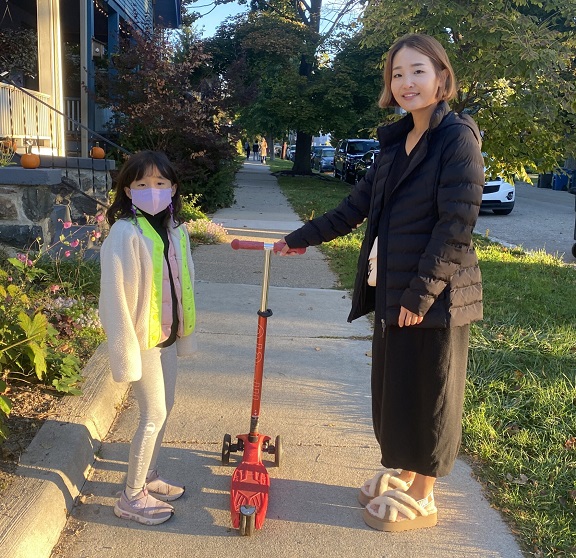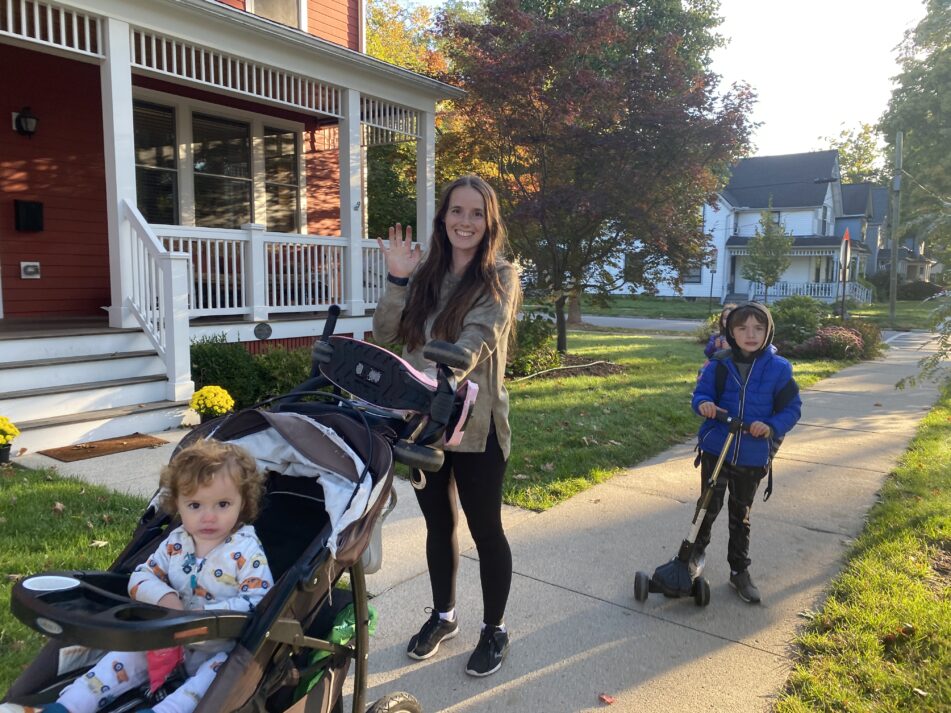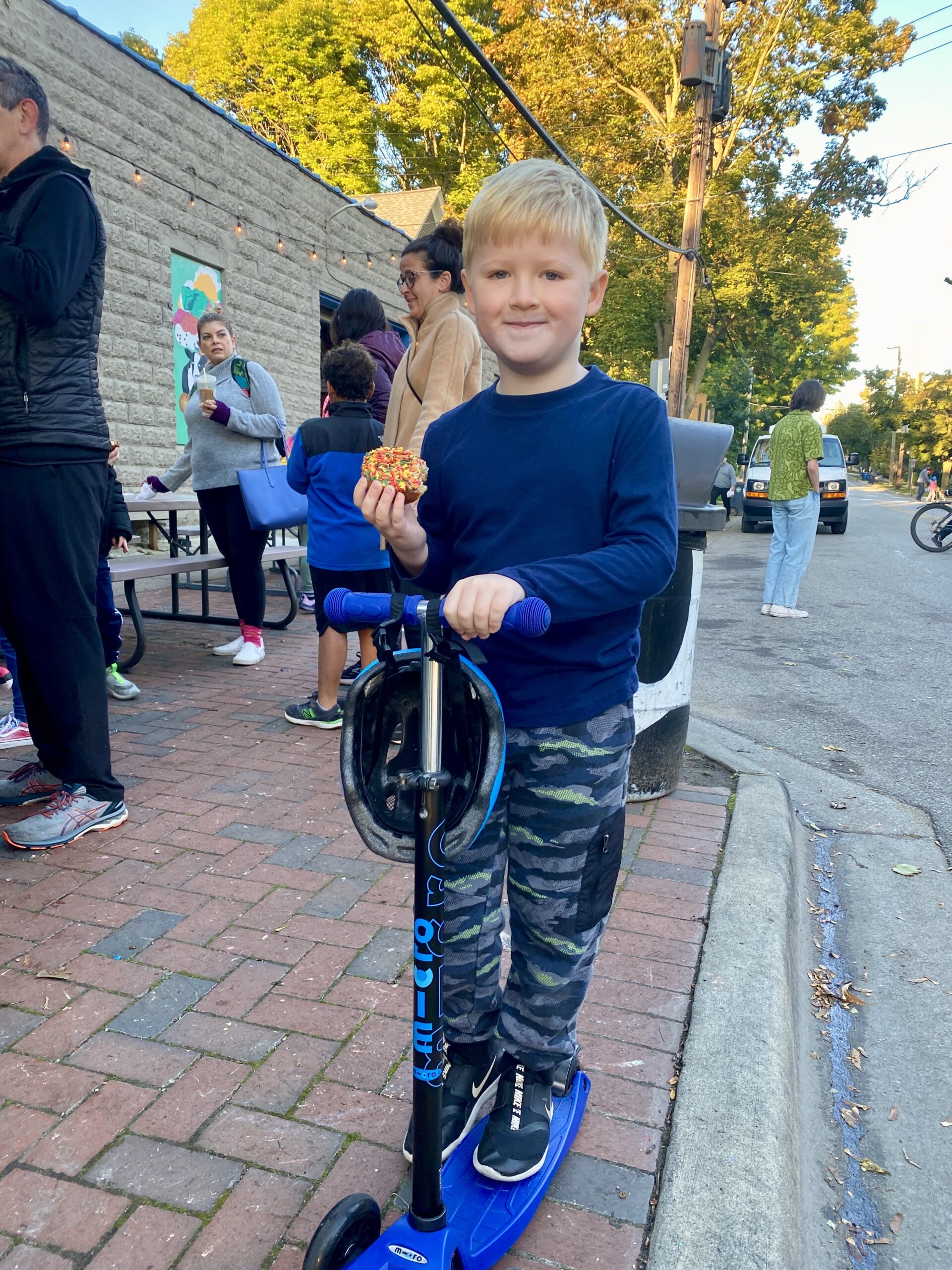AAPS, city work together to support safe walking and biking to school for students

By Jo Mathis/AAPS District News
Bach third grade teacher Cameron Dominick normally drives himself and fourth grade son, Henry, the three miles to school every morning.
But on Monday, they jumped on their bikes to make the trip, joining many others in the Bach community who celebrated Walk, Bike & Roll to School Day.
“It’s amazing,” he said, looking at the crowd of kids with bikes and scooters gathering with friends and family outside Washtenaw Dairy, where many started the day with a doughnut. “It’s great to promote activity and movement, getting kids out moving their bodies. We just wanted to be part of it.”
His son, Henry Dominick, agreed, saying: “I like doing this because it’s the only time we ride a bike to school.”
AAPS will participate in the 26th annual National Walk & Roll to School Day on Oct. 12 building-by-building, while busses will stop a few blocks from school to allow those students to walk the final way.
Ann Arbor Public School and the city of Ann Arbor, through the Safe Route to School Partnership, are ready to celebrate the National Walk & Roll to School Day on Oct. 12.
Thousands of students across AAPS walk or bike to school throughout the year, but the activities are particularly encouraged in October. Everyone can participate, as student bus riders are dropped off a few blocks from school to walk the rest of the way with volunteers.
Working with the City of Ann Arbor traffic engineers, who are part of the district’s Safe Routes to School teams, many improvements continue to be made throughout the neighborhoods to create safer walk and bike paths for students and families. These include bump-outs, pedestrian crossings, signalized crossings, and limitations of car and bus locations to ensure safe arrivals of walkers and bikers.
Through the Michigan Fitness Safe Routes to School program, many AAPS schools receive mini-grants to assist in their SRTS efforts including the walk and bike to school days, bike racks, and educational programs for students and families.

Ann Arbor is known as a walking and biking community, says Liz Margolis, who oversees the district’s safety protocols.
“AAPS continues to support these modes of travel with students wherever it is safely available,” she says. “Walk to School Day events raise awareness of the continued need to create safer routes for walking and bicycling and emphasize the importance of issues such as increasing physical activity among children, pedestrian safety, traffic congestion, and concern for the environment. The events build connections between families, schools, and the broader community.”
Bach parent John Bacon says his son, Teddy, has been talking about riding his scooter to school for a week.
“It’s a ton of fun,” says Bacon. “One of the many things we love about Bach School.”

Comprehensive Safe Routes to School initiatives have been shown to be more effective at increasing physical activity and reducing injuries. The Six Es of Safe Routes to School summarize the key components of a comprehensive, integrated approach. For more information about how each of the 6 Es factor into a comprehensive Safe Routes to School program, and tools to support including the 6 Es, see The Basics of Safe Routes to School.
ENGAGEMENT – All Safe Routes to School initiatives should begin by listening to students, families, teachers, and school leaders and working with existing community organizations, and build intentional, ongoing engagement opportunities into the program structure.
EQUITY – Ensuring that Safe Routes to School initiatives are benefiting all demographic groups, with particular attention to ensuring safe, healthy, and fair outcomes for low-income students, students of color, students of all genders, students with disabilities, and others.
ENGINEERING – Creating physical improvements to streets and neighborhoods that make walking and bicycling safer, more comfortable, and more convenient.
ENCOURAGEMENT – Generating enthusiasm and increased walking and bicycling for students through events, activities, and programs.
The 6 Es of Safe Routes to School
EDUCATION – Providing students and the community with the skills to walk and bicycle safely, educating them about benefits of walking and bicycling, and teaching them about the broad range of transportation choices.
EVALUATION – Assessing which approaches are more or less successful, ensuring that programs and initiatives are supporting equitable outcomes, and identifying unintended consequences or opportunities to improve the effectiveness of each approach.
Note: Effective June 2020, the Safe Routes Partnership dropped Enforcement as one of the 6 Es of Safe Routes to School and added Engagement as the first E.

























